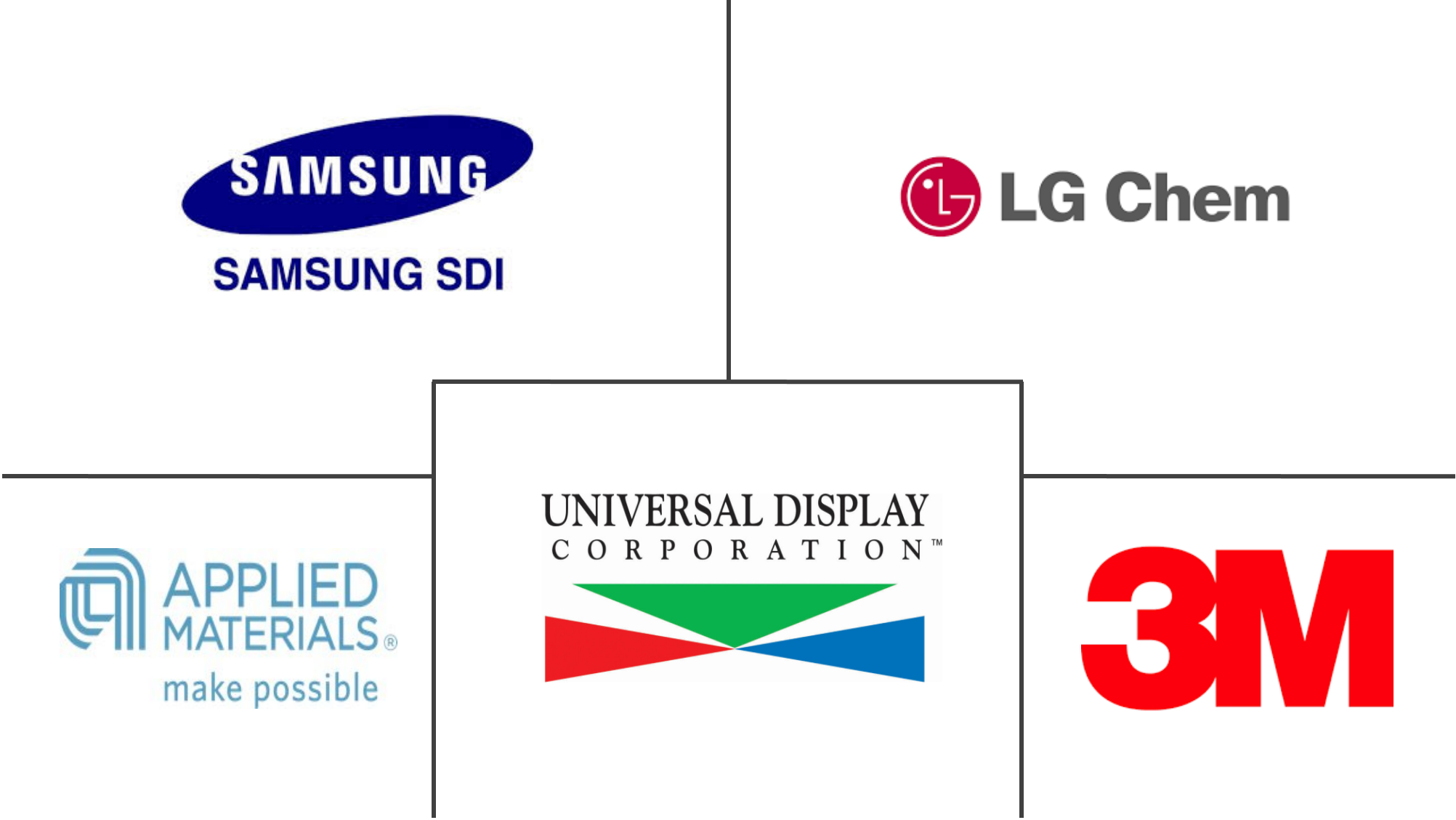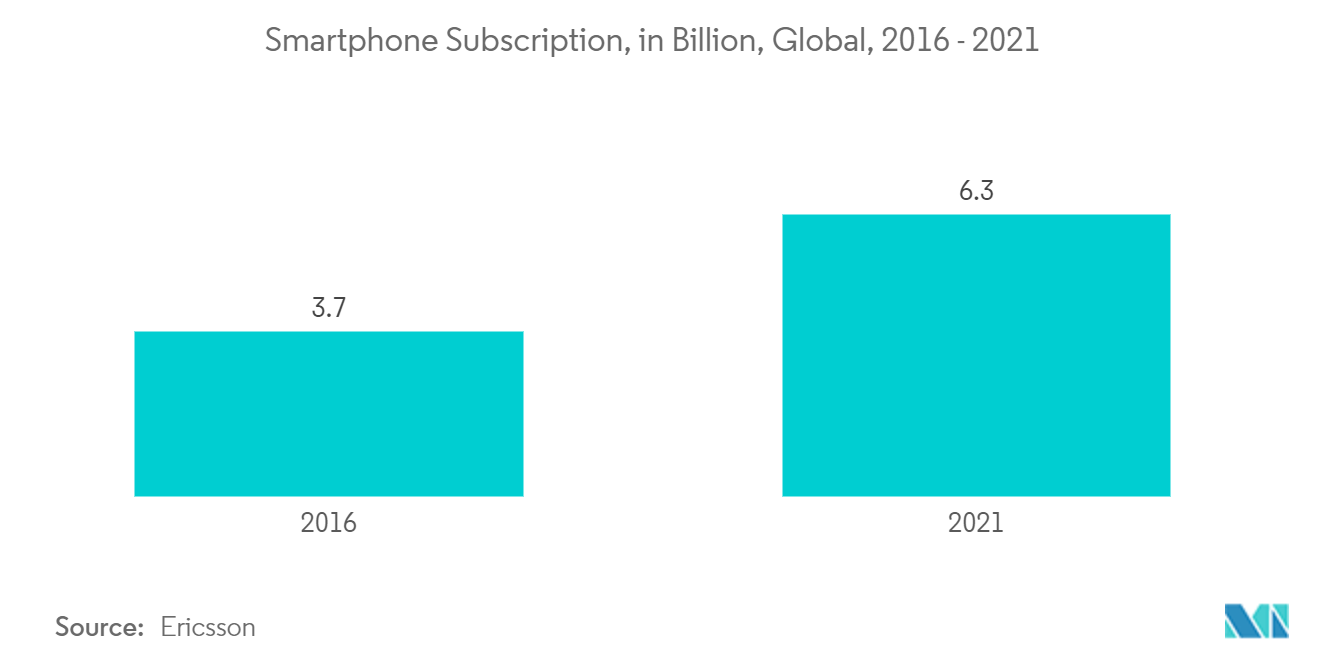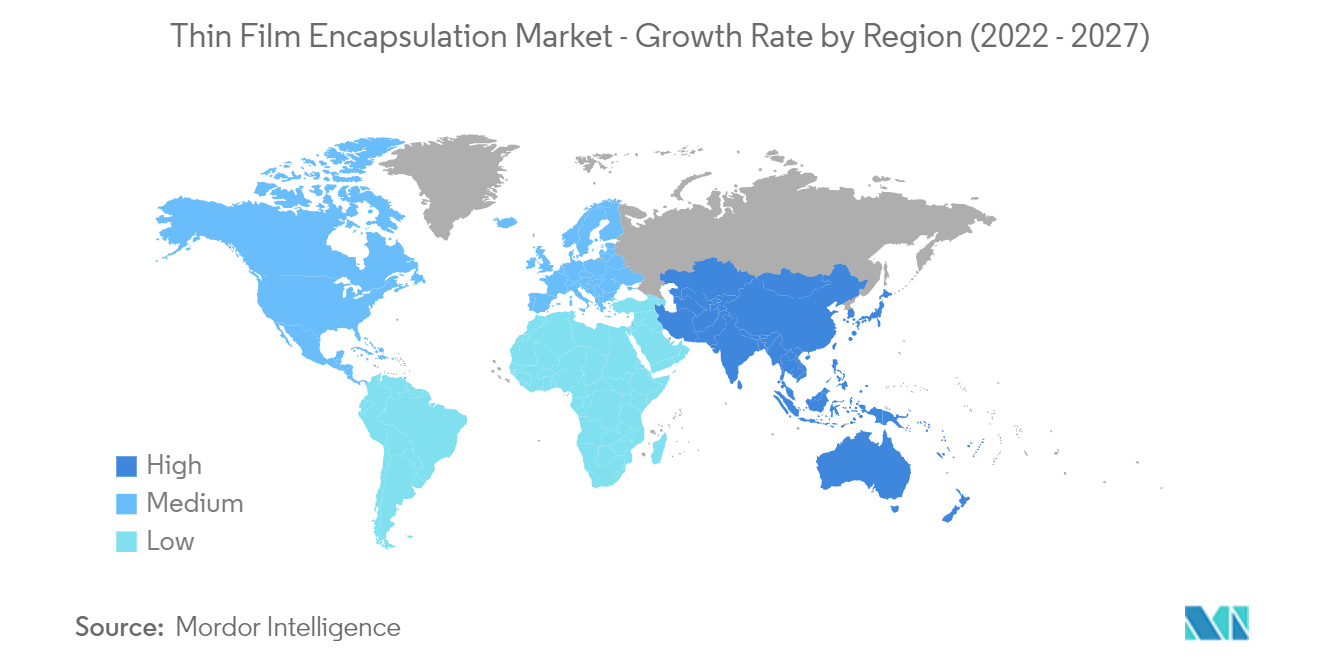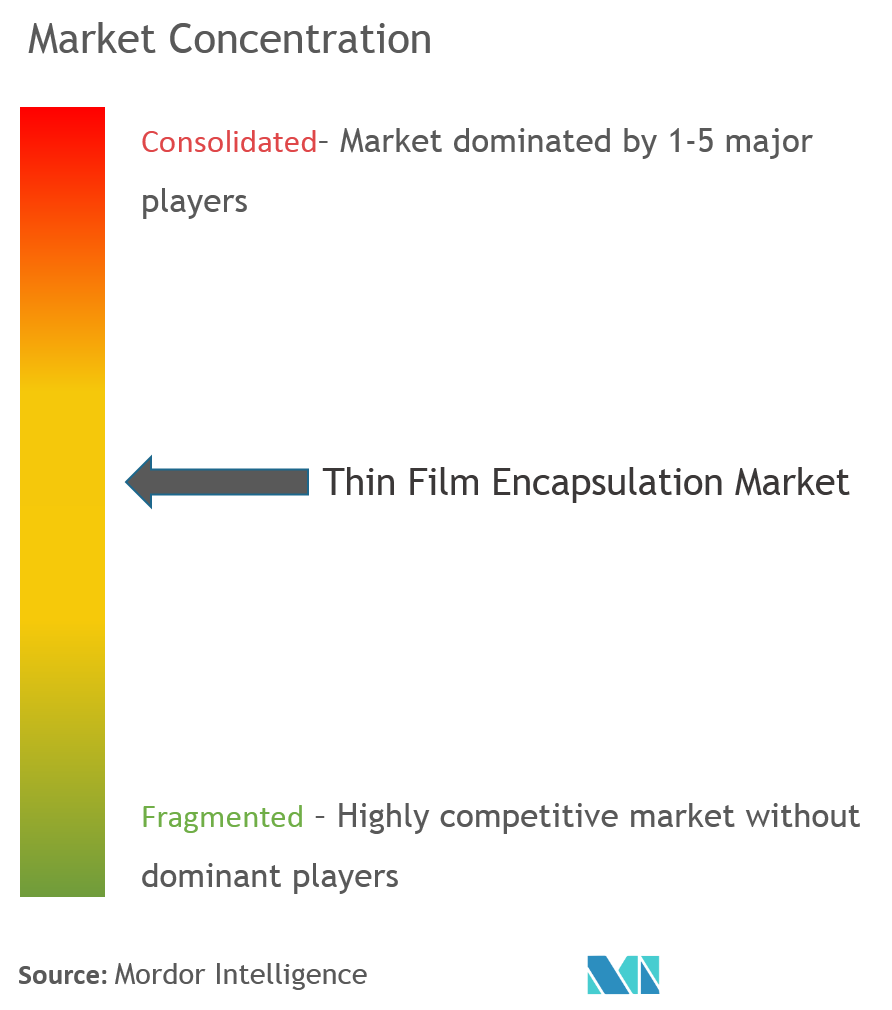Thin Film Encapsulation Market Size

| Study Period | 2019 - 2029 |
| Base Year For Estimation | 2023 |
| CAGR | 14.80 % |
| Fastest Growing Market | Asia Pacific |
| Largest Market | Asia Pacific |
| Market Concentration | Medium |
Major Players
*Disclaimer: Major Players sorted in no particular order |
Thin Film Encapsulation Market Analysis
The Thin Film Encapsulation (TFE) market is projected to grow by registering a CAGR of 14.8% during the forecast period. Progress in the requirement for the thin-film barrier in numerous flexible devices, growth in the adoption rate of flexible OLED displays for smart devices, and growth capital investments in OLED technology have been driving the global thin-film encapsulation (TFE) market. On the other hand, a lack of technological knowledge and the augmentation of flexible glass technology may hinder the global market. The demand for flexible OLED lighting is expected to increase as the adoption of OLED lighting in automotive applications proliferates during the forecast period.
- Thin-film Encapsulation (TFE) is based on a multilayer film composed of alternate organic and inorganic layers. The inorganic layers are typically metal oxides and serve as moisture barriers. These layers are almost impenetrably substantial barriers but are mechanically rigid and brittle. Furthermore, these layers would naturally have pinhole defects, allowing water and oxygen in the long run. Organic planarization interlayers are used in standard TFE structures to improve the mechanical properties of the multilayer (flexibility without delamination) and limit water permeation through the pinholes to some extent.
- TFE has the strength to replace the front glass layer with a thin-film barrier present in an OLED device. OLED material is very susceptible to degeneration when exposed to different environmental factors such as water and air. Successful TFE commits to enabling flexible OLED and decreasing cost by replacing glass as the substrate material ending in a lighter and thinner display.
- Technological innovations, growing investments, and IP protections have significantly affected the TFE market over the ages. In combination with enhanced flexibility and robustness, decreased device thickness, cheap cost, and weight are the significant benefits of TFE technology. The latest technologies, such as atomic layer deposition (ALD) and inkjet printing, are anticipated to impact the market during the estimated period. The price of the raw material license, cost of equipment, and optimization in several processes have further driven the market.
- With the rise of wearable devices, flexible active-matrix OLEDs have emerged as the future display technology. Because of their inherent rigidity, conventional encapsulation methods are unsuitable for protecting flexible devices, and Thin Film Encapsulation (TFE) has been regarded as the most promising technology. Furthermore, in recent years, many automotive companies have colluded with lighting companies to produce car OLED lighting solutions. OLED lighting solutions can give better efficiency than traditional incandescent lighting; they also provide opportunities to put a light in new and seldom startling places that are only beginning to surface in the quickly growing field, which could further boost the Thin Film Encapsulation market.
- However, technical innovations in display technologies, such as flexible glass, are expected to challenge the growth of the studied market. For instance, with new high-yield mass-production equipment and the advent of new materials and fabrication technologies, OLED technology would enable the next leap in new flexible products, providing freedom from glass substrates.
- The COVID-19 pandemic disrupted supply chains and influenced the purchasing decisions and the spending behavior of end-user industries. Furthermore, the pandemic also halted production and other operations in the manufacturing sector. The global thin film encapsulation market has had a negative impact on COVID-19. Lockdown measures reduced demand for electronic gadgets, which had a global impact on the semiconductor sector. The continued decline in worldwide demand and automobile export shipments negatively impacted the market, slowing the demand for semiconductor manufacturing equipment.
Thin Film Encapsulation Market Trends
This section covers the major market trends shaping the Thin Film Encapsulation Market according to our research experts:
Flexible OLED Display Segment to Hold Significant Market Share
- The Flexible organic light-emitting diode (OLED) will be the most advanced display technology for buyers and industries in the near future. Thin-film encapsulation (TFE) technology is the utmost demanding necessity to prevent water and oxygen penetration into flexible OLED devices as a polymer substrate does not offer the identical barrier performance as glass, the TFE development on both the bottom and top side of the device layers for good lifetimes.
- With excellent display quality, such as perfect video capability, vivid full color, and thin form factor, AMOLED (active-matrix organic light-emitting diode) is progressing into OLED TV (television), mobile devices, and smartwatches are poised to access consumer markets in the near future. AMOLED on flexible substrates would be considered the ultimate display because of its ruggedness and versatility. There are several hurdles to realizing flexible AMOLED, particularly on plastic substrates. Among these difficulties, TFE is the most demanding task because OLED demands the most significant degree of moisture and oxygen penetration protection in electronic gadgets.
- The increasing demand for smartphones and wearable devices with innovative features is expected to play a crucial role in the growth of the flexible display market. For instance, according to Ericsson, smartphone subscription was expected to reach 6.3 billion in 2021.
- Considering the recent success of foldable smartphones, several vendors are increasing their R&D efforts to develop the technology further. For instance, in December 2021, LG Display announced that, at CES2022, it would demonstrate how its flexible OLED technology creates new and different lifestyles. The company also announced the unveiling of two new products that would use OLED displays.
- Furthermore, OLED technologies are persistently meeting the demands of customers and markets. The success of flexible OLED applications still needs further advancements in the technology of TFE. Numerous barrier architectures are possible, and each technology has distinctive materials, processing, and barrier characteristics. The principal benefit of this approach is that it can obtain low WVTR (water vapor transmission rate) with fewer layers because ALD/MLD layers have much more satisfying film integrity. Still, the disadvantage has been the low throughput and restraint in the scalability of the MLD/ALD process.
- Therefore, more excellent knowledge of the synergistic effect of polymer/inorganic multilayers may lead to enhanced barrier performance from simplistic structures. However, there are still problems with making practically the TFE on extensive area/flexible OLED application. Hence, a novel ALD and MLD system will give a significant breakthrough and opportunity for TFE in the OLED industry.

Asia-Pacific Expected to Witness the Highest Growth Rate
- Asia-Pacific is expected to hold a significant market share in the thin-film encapsulation market. The regional market's growth can be associated with the progression of the electronics and semiconductor industries, mainly in China. The deep-rooted electronics manufacturing bases in South Korea, China, and Taiwan led to an enhanced demand for thin film encapsulation technologies.
- Moreover, in a region with restrictive regulatory policies on FDI across the industries, the electronics-manufacturing area is more open to FDI compared with the national averages for all the merged sectors. Government policies, especially in recent years, have supported establishing the dynamic electronics industry in the area, which is expected to create a favorable market scenario for the thin film encapsulation industry. For instance, in 2021, the Indian government launched an INR 76,000 crore PLI scheme to boost the country's semiconductor and display manufacturing industry.
- The increase in industrialization and an addition in the number of end-user industries in developing economies, such as China and India, have offered various untapped opportunities. Moreover, China, Indonesia, South Korea, Japan, and Taiwan have led the thin-film encapsulation market growth due to growing solar panel manufacturing and installations. According to IEA, China currently manufactures and supplies about 80 percent of the world's solar photovoltaic (PV) panels.
- Additionally, the growing demand for electronic components and display panels from the automotive industry is expected to boost the demand for semiconductors, and display units in the region, directly affecting the market studied accurately.

Thin Film Encapsulation Industry Overview
The Thin Film Encapsulation Market is moderately competitive and consists of several major players. Regarding market share, some of the major players currently dominate the market. The end-users demand is driven by safety and regulatory needs, and the companies operating in the market are leveraging strategic collaborative initiatives to offer specialized solutions to increase their market share and profitability. The companies operating in the market are also into mergers and acquisitions of start-ups that help improve the served market portfolio on Thin Film Encapsulation technology to strengthen their product capabilities. Some notable vendors in the market include Samsung SDI Co., Ltd., LG Chem, Applied Materials Inc., and 3M, among others.
- September 2022 - LG Display developed an OLED on Silicon and a highly efficient color filter structure. The thin film encapsulant of the display is made 2.5 micrometers thick, enough for the light not to leak out, and prevents different colors of light from mixing. To develop the product, the company used color filter materials and processes to help it form at 100 Celsius to protect the OLED material.
- August 2022 - LG Electronics (LG) introduced LG OLED Flex (model LX3), an innovative bendable 42-inch OLED screen for immersive consoles, live TV broadcasts, PC and cloud gaming, and content streaming services. The LX3's display can go from flat to curve (900R), allowing users to choose their ideal arc from twenty levels of curvature for a personalized viewing experience.
Thin Film Encapsulation Market Leaders
-
Samsung SDI Co.,Ltd.
-
LG Chem
-
Applied Materials, Inc.
-
Universal Display Corp. (UDC)
-
3M
*Disclaimer: Major Players sorted in no particular order

Thin Film Encapsulation Market News
- April 2022 - Samsung Display started working on developing a thinner version of its quantum dot (QD)-OLED panel with the aim is to reduce the use of glass substrates to one. The project's success will enable the company to launch the new version of QD-OLED in a rollable format.
- December 2021 - Unijet, an Inkjet printing firm, supplied inkjet equipment for micro OLED to China's Sidtek. The company will use the equipment for thin-film encapsulation of micro OLED displays. This was the first time Unijet supplied TFE inkjet equipment for commercial production.
Thin Film Encapsulation Market Report - Table of Contents
1. INTRODUCTION
- 1.1 Study Assumptions and Market Definition
- 1.2 Scope of the Study
2. RESEARCH METHODOLOGY
3. EXECUTIVE SUMMARY
4. MARKET INSIGHTS
- 4.1 Market Overview
-
4.2 Industry Attractiveness - Porter's Five Forces Analysis
- 4.2.1 Threat of New Entrants
- 4.2.2 Bargaining Power of Buyers
- 4.2.3 Bargaining Power of Suppliers
- 4.2.4 Threat of Substitute Products
- 4.2.5 Intensity of Competitive Rivalry
- 4.3 Assessment of Impact of COVID-19 on the Market
5. MARKET DYNAMICS
-
5.1 Market Drivers
- 5.1.1 Increase in Demand for Microelectronics and Consumer Electronics Products
- 5.1.2 Increased Adoption of Flexible OLED Displays for Smartphones and Smart Wearables
-
5.2 Market Restraints
- 5.2.1 High Capital Investment in R&D for Developing Upgraded Products
- 5.2.2 Augmented Growth of Flexible Glass
6. MARKET SEGMENTATION
-
6.1 By Technology
- 6.1.1 Plasma-enhanced chemical vapor deposition (PECVD)
- 6.1.2 Atomic layer deposition (ALD)
- 6.1.3 Inkjet Printing
- 6.1.4 Vacuum Thermal Evaporation (VTE)
- 6.1.5 Other Technologies
-
6.2 By Application
- 6.2.1 Flexible OLED Display
- 6.2.2 Thin-Film Photovoltaics
- 6.2.3 Flexible OLED Lighting
- 6.2.4 Other Applications
-
6.3 By Geography
- 6.3.1 North America
- 6.3.2 Europe
- 6.3.3 Asia Pacific
- 6.3.4 Rest of the World
7. COMPETITIVE LANDSCAPE
-
7.1 Company Profiles
- 7.1.1 Samsung SDI
- 7.1.2 LG Chem
- 7.1.3 Universal Display Corp. (UDC)
- 7.1.4 Applied Materials Inc.
- 7.1.5 Veeco Instruments Inc.
- 7.1.6 3M
- 7.1.7 Toray Industries Inc.
- 7.1.8 Kateeva
- 7.1.9 BASF (Rolic) AG
- 7.1.10 Meyer Burger Technology Limited
- 7.1.11 AMS Technologies
- 7.1.12 Bystronic Glass
- 7.1.13 Aixtron SE
- 7.1.14 Angstrom Engineering Inc.
- 7.1.15 Lotus Applied Technology
- 7.1.16 Beneq Inc.
- *List Not Exhaustive
8. INVESTMENT ANALYSIS
9. FUTURE OUTLOOK OF THE MARKET
** Subject To AvailablityThin Film Encapsulation Industry Segmentation
Thin Film Encapsulation is a technology used in organic light-emitting diodes (OLED) devices such as monitors, TVs, laptops, cameras, and lamps for guarding the displays against the external environment such as air, moisture, and water. It is a multi-layer film made up of inorganic and organic layers. These films are highly rigid and fragile in nature and act as solid barriers.
The scope of the study focuses on the market analysis of Thin Film Encapsulation. The study also tracks the key market parameters, underlying growth influencers, and major vendors operating in the industry, which supports the market estimations and growth rates over the forecast period. The study further analyzes the overall impact of COVID-19 on the ecosystem. The report's scope encompasses market sizing and forecast for segmentations.
| By Technology | Plasma-enhanced chemical vapor deposition (PECVD) |
| Atomic layer deposition (ALD) | |
| Inkjet Printing | |
| Vacuum Thermal Evaporation (VTE) | |
| Other Technologies | |
| By Application | Flexible OLED Display |
| Thin-Film Photovoltaics | |
| Flexible OLED Lighting | |
| Other Applications | |
| By Geography | North America |
| Europe | |
| Asia Pacific | |
| Rest of the World |
Thin Film Encapsulation Market Research FAQs
What is the current Thin Film Encapsulation Market size?
The Thin Film Encapsulation Market is projected to register a CAGR of 14.80% during the forecast period (2024-2029)
Who are the key players in Thin Film Encapsulation Market?
Samsung SDI Co.,Ltd., LG Chem, Applied Materials, Inc., Universal Display Corp. (UDC) and 3M are the major companies operating in the Thin Film Encapsulation Market.
Which is the fastest growing region in Thin Film Encapsulation Market?
Asia Pacific is estimated to grow at the highest CAGR over the forecast period (2024-2029).
Which region has the biggest share in Thin Film Encapsulation Market?
In 2024, the Asia Pacific accounts for the largest market share in Thin Film Encapsulation Market.
What years does this Thin Film Encapsulation Market cover?
The report covers the Thin Film Encapsulation Market historical market size for years: 2019, 2020, 2021, 2022 and 2023. The report also forecasts the Thin Film Encapsulation Market size for years: 2024, 2025, 2026, 2027, 2028 and 2029.
Thin Film Encapsulation Industry Report
Statistics for the 2024 Thin Film Encapsulation market share, size and revenue growth rate, created by Mordor Intelligence™ Industry Reports. Thin Film Encapsulation analysis includes a market forecast outlook 2029 and historical overview. Get a sample of this industry analysis as a free report PDF download.



